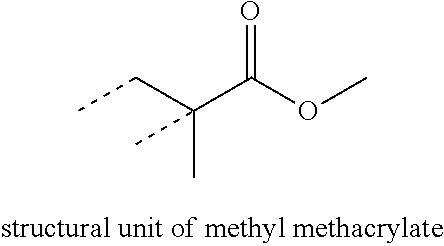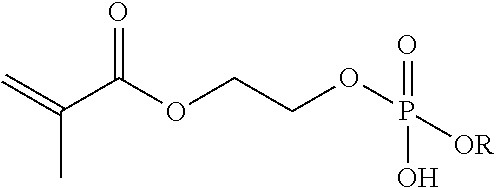Bimorphological latex
a technology of bimorphology and latex, applied in the field of bimorphology latex, can solve the problems of limited flexibility of use of relatively inexpensive letdown binder, high cost of titanium dioxide (tiosub>2/sub>) in many pigmented coating formulations,
- Summary
- Abstract
- Description
- Claims
- Application Information
AI Technical Summary
Benefits of technology
Problems solved by technology
Method used
Image
Examples
example 1
on of Bimorphological Polymer Particles
A. Core (Preform) Synthesis
[0042]A first monomer emulsion was prepared by mixing deionized water (200 g), Disponil FES 993 surfactant (43 g, 30% active), butyl acrylate (371.2 g), methyl methacrylate (195.2 g), allyl methacrylate (9.6 g), phosphoethyl methacrylate (51.2 g, 60% active), and methacrylic acid (12.8 g).
[0043]To a 5-L, four necked round bottom flask equipped with a paddle stirrer, a thermometer, nitrogen inlet, and a reflux condenser was added deionized water (600 g) and Disponil FES 32 surfactant (43 g, 30% active). The contents of the flask were heated to 85° C. under N2 and stirring was initiated. A portion of the first monomer emulsion (70 g) was then added, quickly followed by a solution of sodium persulfate (2.56 g) dissolved in deionized water (30 g) followed by a rinse of deionized water (5 g). After stirring for 10 min, the remainder of the first monomer emulsion, followed by a rinse (25 g), and an initiator solution of sod...
examples 2-6
[0047]The procedure used to prepared compositions of Examples 2-6 was substantially the same as described in Example 1 except that the portions of the second monomer emulsion and the pre-form were varied to achieve different w / w ratios of non-protuberating to protuberating particles, different particle sizes. Table 1 illustrates amounts of preform and second monomer emulsion (ME2) as a percentage of the total monomer used to prepare the particles; the particle sizes (PS) of the particles, and the w / w ratio of the non-protuberating to protuberating particles. If desired, particle size and particle size ratios can be further manipulated through control of surfactant concentration in the reactor at the onset of polymerization.
[0048]
TABLE 1Amounts, Particle Sizes, and w / w Ratios ofBimorphological Polymer ParticlesNon-protubProtubRatioEx. No.% Preform% ME2PS (nm)PS (nm)NonPro:Pro15.03.510913953.1:46.922.53.511714770.3:29.737.53.510313440.1:59.9410.03.58912534.0:66.055.02.510213846.7:53.3...
PUM
| Property | Measurement | Unit |
|---|---|---|
| volume average particle size | aaaaa | aaaaa |
| volume average particle size | aaaaa | aaaaa |
| weight percent | aaaaa | aaaaa |
Abstract
Description
Claims
Application Information
 Login to View More
Login to View More - R&D
- Intellectual Property
- Life Sciences
- Materials
- Tech Scout
- Unparalleled Data Quality
- Higher Quality Content
- 60% Fewer Hallucinations
Browse by: Latest US Patents, China's latest patents, Technical Efficacy Thesaurus, Application Domain, Technology Topic, Popular Technical Reports.
© 2025 PatSnap. All rights reserved.Legal|Privacy policy|Modern Slavery Act Transparency Statement|Sitemap|About US| Contact US: help@patsnap.com



